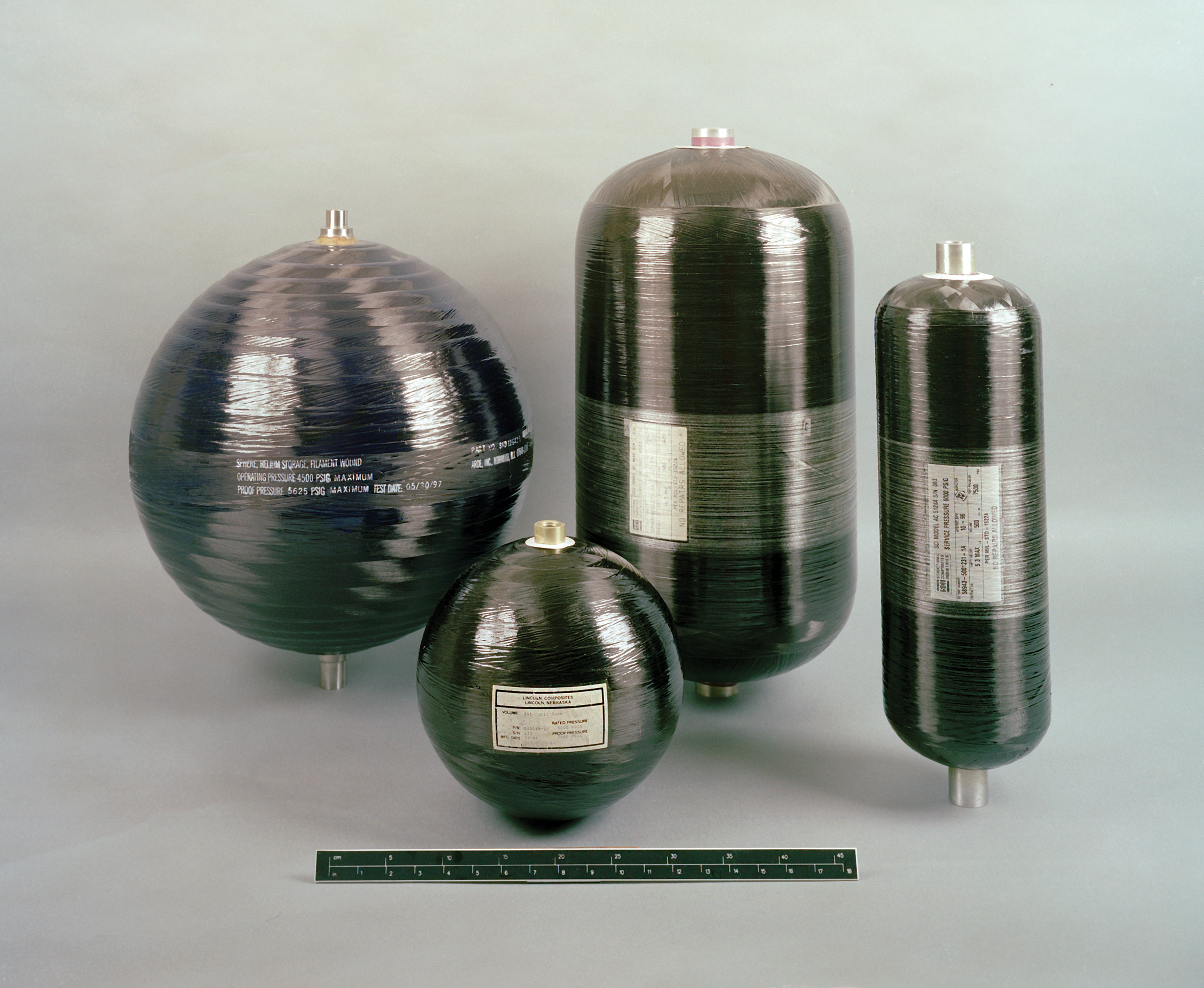The Technical Discipline Team (TDT) for Structures was actively engaged in various investigations throughout the previous year, with a particular focus on composites, fracture mechanics, and pressure vessels. These specialties play a pivotal role in the realm of composite overwrapped pressure vessels (COPV). An essential discovery made by the TDT was the identification of an inherent vulnerability that leads to an underestimation of structural life. This issue is attributed to the existing specifications and testing standards for COPVs. The work conducted by the NASA Engineering and Safety Center (NESC) and the subsequent recommendations put forth are poised to significantly enhance the safety and success of current and future COPV operations within the aerospace sector.
Challenges with Damage Tolerance Analysis Standard for COPVs
COPVs are comprised of a metallic liner that houses the fluid or gas and a composite overwrap that provides structural reinforcement (see Figure 1). The pressure cycles involved in the operation of a spaceflight COPV typically commence with an initial overpressure phase known as autofrettage, where the metallic liner undergoes yielding while the composite overwrap retains its elasticity. The yielding of the liner during autofrettage leads to slight liner expansion, resulting in compression upon depressurization post-autofrettage. Subsequent operational cycles can either be elastic or elastic-plastic in nature.
 Figure 1. Illustration depicting the major components of a COPV.
Figure 1. Illustration depicting the major components of a COPV.
The evaluation of damage tolerance life for spaceflight COPVs is governed by the ANSI/AIAA-S-081B standard, which outlines the baseline requirements for conducting damage tolerance analyses (DTA) for COPVs with elastically responding liners. The standard permits the consideration of the elastic-plastic autofrettage cycle independently of the elastically responding cycles in the DTA. While the elastically responding cycles can be analyzed using linear elastic fracture mechanics (LEFM) tools like the NASGRO crack-growth analysis software, the standard does not account for any adverse effects of the autofrettage cycle.
In a study titled “Unconservatism of Linear-Elastic Fracture Mechanics Analysis Post Autofrettage (NASA/TM-20230013348),” an NESC team conducted experimental and analytical investigations into the impact of the autofrettage cycle on subsequent elastic cycles. Tests were conducted on coupons with part-through surface cracks subjected to cyclic loading representative of COPV liner operational cycles. The results indicated that cracks in tests involving the autofrettage cycle exhibited faster growth compared to identical tests excluding the autofrettage cycle, as evidenced by the fracture surfaces in photomicrographs (refer to Figure 2). The experimental and simulated findings highlighted the unconservatism of the damage tolerance analysis approach permitted by the standard.
 Figure 2. Fracture surfaces from two identical tests illustrating crack growth with and without an initial autofrettage cycle.
Figure 2. Fracture surfaces from two identical tests illustrating crack growth with and without an initial autofrettage cycle.
A validated finite element analysis and experimental measurements were utilized to assess the influence of the autofrettage cycle. The elastic-plastic nature of the autofrettage cycle was found to induce significant plastic deformation ahead of the crack, blunting the crack tip. While prior studies focused on elastic overloads and their impact on crack growth, the crack blunting observed in this study allowed the crack to remain open throughout the loading process. The discrepancies observed between tests with and without the autofrettage cycle underscored the need for an alternative damage tolerance analysis approach, prompting the NESC to recommend updates to the ANSI/AIAA S-081B standard to address COPV liners experiencing compressive stresses post-autofrettage.
 Figure 3. Abaqus finite element analysis demonstrating crack growth with and without an autofrettage cycle, with crack opening displacement on the Y-axis and crack length on the X-axis.
Figure 3. Abaqus finite element analysis demonstrating crack growth with and without an autofrettage cycle, with crack opening displacement on the Y-axis and crack length on the X-axis.
An Overview of Damage Tolerance for COPVs
The ANSI/AIAA S-081B standard serves as a comprehensive guide encompassing accepted practices for COPVs utilized in space applications. Developed through collaboration among industry, government, and academic entities, this standard covers diverse aspects of COPVs, including damage tolerance life analyses crucial for flight qualification overseen by fracture control boards. The standard mandates that a COPV must withstand four operational lifetimes with the largest crack in the metallic liner undetectable by nondestructive evaluation (NDE) under representative stresses experienced throughout its lifecycle. The operational lifespan of a COPV typically involves an initial elastic-plastic cycle (autofrettage or proof) followed by subsequent elastic or elastic-plastic cycles. The autofrettage process involves pressurizing the COPV to compress the liner inner surface, rendering it less susceptible to operational stresses. While COPVs with elastically responding liners can undergo damage tolerance qualification using LEFM tools, those with plastically responding liners necessitate testing for qualification. Guidance on assessing the suitability of LEFM tools for COPV damage tolerance was provided in NESC Technical Bulletin No. 21-04 and NASA/TM-2020-5006765/Volumes 1⁄2.
Future Outlook for the Structures Discipline
As NASA increasingly forges strategic partnerships with commercial entities through new programs, the Structures TDT emphasizes the importance of aligning with appropriate requirements as a strategic focus. While NASA Standards are often referenced, their prescriptive nature may not always align with the needs of commercial contracts. Consequently, industry partners and NASA team members develop tailored standards specific to each program, leading to inconsistencies in detailed requirements across different initiatives. The evolution of technologies such as soft goods, large-scale deployable structures, inflatables, probabilistic analysis methods, and additive manufacturing necessitates unique requirements. The TDT has identified the necessity for a tailoring guide linked to mission priorities and risk profiles to aid in insight and oversight strategies for NASA programs. Collaboration among Structures TDT members from various centers and programs facilitates effective interpretation of requirements, ensuring the safety of NASA personnel and the success of operations in these emerging commercial programs.
